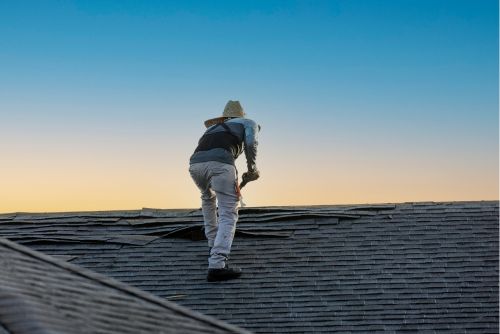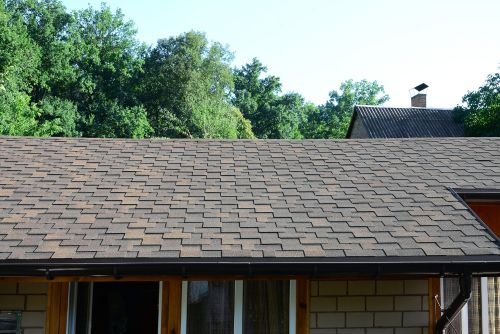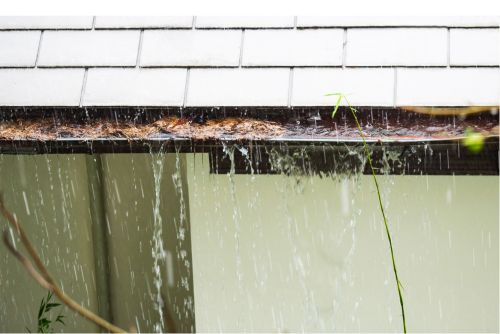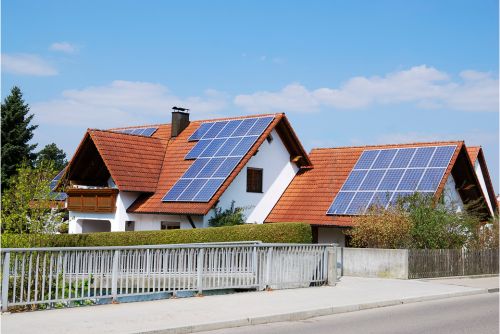Have you ever wondered what those rectangular pieces on your roof are called? Well, let me introduce you to the world of shingles! So, what is a shingle on a roof?
A shingle is a small, flat piece that is used to cover the roof of a building. It serves as a protective layer against weather elements such as rain, snow, and sunlight. Shingles come in various materials and styles, each with its own unique characteristics. Now, let's dive into the different types of shingles available for your roofing needs.
One popular option is asphalt shingles, which are made from fiberglass or organic materials coated with asphalt. These shingles are durable and affordable, making them a common choice for homeowners.
Another option is slate shingles which exude elegance and sophistication. They are made from natural stone slabs and can withstand extreme weather conditions.
Lastly, there are wood shingles that add a rustic charm to any home. Made from cedar or redwood, these shingles require regular maintenance but offer excellent insulation properties.
Innovation in the world of roofing has brought about exciting advancements in shingle technology. From energy-efficient options that reduce electricity usage to eco-friendly materials that minimize environmental impact - there's something for everyone!
So whether you're looking to upgrade your existing roof or embark on an entirely new project, understanding the different types of shingles available will help you make an informed decision. Get ready to transform your roof into a stylish and functional masterpiece!
Roof shingles protect against the elements and add aesthetic appeal. Asphalt shingles are the most common roofing material. Asphalt, fiberglass, and ceramic granules make these shingles durable and protective.
Asphalt shingles are installed by layering them to create a water-tight barrier. Shingle roofing adds beauty and function to a building. Different shingles can create different styles. Three-dimensional shingles add depth and texture to the roof and are a popular choice. These shingles let homeowners customize their roofs with different colors and patterns.
Shingle installation requires precision. It requires measuring and cutting the shingles to fit the roof without gaps or overlaps. To withstand strong winds and other weather, each shingle is securely nailed down.
Moving on to 'types of shingles,' it's important to know that you have several options when choosing a roof shingle. Each type has distinct pros and cons. Let's explore different roofing shingles and how they can improve your home or building's function and aesthetics to help you make an informed decision that meets your needs and preferences.

Imagine walking through a charming neighborhood and seeing the variety of styles and textures on housetops, each telling a story about its owner. That's when you realize shingle diversity. Many types and materials of roof shingles allow homeowners to express their style while protecting their homes from the elements. There are shingle roofs for every style, from wood shakes to metal panels.
Asphalt roof shingles are popular. These versatile shingles are made of asphalt-coated fiberglass or organic materials. Due to their affordability, durability, and ease of installation, they're popular. Asphalt shingles are available in many colors and styles, allowing homeowners to customize their roofs. Asphalt shingles can be beautiful and functional, whether you prefer slate or cedar shake.
Wood shakes appear natural and timeless but require more maintenance than other roof shingles. Any home looks sleek and modern with metal panels, which are durable and energy efficient. Eco-friendly shingles made from recycled materials reduce waste without sacrificing quality.
As you can see, roof shingles are plentiful. Each material offers unique benefits and characteristics.
When walking through a charming neighborhood, you can't help but admire the variety of styles and textures on housetops, each telling a story about its owner.
Asphalt shingles are popular roofing shingles. Due to their affordability and ease of installation, these versatile and durable materials are roofing industry staples. Asphalt roof shingles are a good choice for someone who values style and functionality.
Asphalt shingles require less roof maintenance than other materials. They can withstand heavy rain and strong winds, making them ideal for unpredictable climates. If asphalt shingles are damaged, professional roofing services can easily replace or repair them.
Asphalt roofing shingles are practical and attractive. Today, homeowners can choose from traditional designs that mimic wood or slate or modern ones with bold colors and unique textures. This versatility lets homeowners express their style while maintaining home character.

Slate shingles are luxurious and durable roofing materials. Natural stone slate shingles are elegant and unique, adding to any home's aesthetic.
They beautify a roof system and last a long time. Slate shingles are extremely durable. Due to their fire, wind, and hail resistance, they have been used as roofing materials for centuries. This makes them a great choice for homeowners seeking a durable roof.
If properly installed and maintained, slate shingles can last over 100 years, making them a smart investment for homeowners. Besides being durable, slate shingles resist moisture penetration. Water cannot seep through dense stone, protecting your home from leaks and water damage. This quality is crucial in rainy or snowy areas. Slate shingles protect your home from moisture, giving you peace of mind.
Slate shingles stand out for their beauty and functionality. The natural appearance adds sophistication to any roof system while providing exceptional weather resistance. Slate shingles are a great roofing material for generations and for home appeal.
It's no wonder slate shingles are so popular among homeowners, given their durability and elegance. If you want to consider other roofing materials, like wood shingles, before choosing one, keep reading!
Imagine entering a cozy cabin among towering pines to experience wood shingles' timeless charm and rustic beauty. It's easy to see why wood shingles have been used for centuries as roofing.
Wood shingles give a roof a warm, natural look unmatched by any other material. They add character to a home, insulate well, and withstand harsh weather.
1. Sustainable: One of the most appealing aspects of wood shingles is their sustainability. Unlike other roofing materials that're manufactured using energy-intensive processes, wood shingles're made from renewable resources. This makes them an environmentally-friendly choice for homeowners who wanna reduce their carbon footprint.
2. Longevity: Despite being made from organic material, wood shingles have proven to be highly durable. With proper maintenance, they can last for decades without losing their aesthetic appeal or structural integrity. This longevity is due in part to the natural oils present in some types of wood that make 'em resistant to rotting and insect damage.
3. Versatility: Wood shingles come in various styles and finishes, allowing homeowners to choose the one that best suits their taste and complements the overall design of their home. Whether you prefer a traditional cedar shake or a more modern sleek profile, there's a wood shingle option available for every architectural style.
After discussing the beauty and benefits of wood shingles as a roofing material, let's talk about colors!

Explore the many wood shingle colors and imagine yourself in a world of vibrant colors and endless possibilities. Roof color can completely change the look and feel of your home.
Wood shingles have many color options, so you can create a unique and eye-catching roof. It comes in a variety of colors to match any architectural style, from warm earth tones like deep browns and rich reds to cool shades like gray and blue. There are colors for every taste, whether you want your home to blend with nature or stand out against a modern backdrop. Wood shingles allow you to mix and match patterns to create a stunning roof that adds character to your home.
Choosing the right wood shingle color involves both personal preference and practicality. Lighter colors reflect sunlight better, keeping your home cooler in the summer. However, darker colors absorb heat, making them ideal for colder climates that require energy efficiency.
Understanding how colors affect energy consumption and temperature regulation lets you choose a roof color that improves both appearance and functionality.
Exploring wood shingle colors allows roofing designers to be creative and innovative. Choose the right roof color to boost curb appeal and energy efficiency.
Color is just one factor in choosing roofing materials. The next section on 'roofing material options' will cover alternatives to wood shingles.
The wide variety of roofing materials lets homeowners choose the best one for their needs and preferences. Many roof shingles are durable, affordable, and attractive. So let's discover more about what is a shingle on a roof and know if it is a good option.
Asphalt roofing is popular due to its versatility and affordability. Asphalt shingles come in many colors and styles, allowing homeowners to customize their home's appearance while protecting it from the elements.
Composite roof shingles are also popular. The fiberglass and asphalt in these shingles make them durable and long-lasting. Composite shingles are a cheaper alternative to slate or wood because they mimic their appearance. They also resist fire and moisture, keeping your home safe and dry.
Slate shingles give any home a luxurious, timeless look. Natural slate is durable and can withstand harsh weather. Slate shingles can last 100 years or more with proper care, despite their higher cost. Their unique beauty and durability make them a good investment for homeowners who value style and function.
Wood shingles add rustic charm to any home's exterior. Cedar or redwood shingles add warmth and character to the design while providing natural insulation. Properly maintained wood shingles can last 30 years without rotting or warping.
With so many roofing material options, homeowners can choose the right one for their style, budget, and durability. It's important to understand how each material's installation and maintenance methods differ as we install roof shingles in the next section.

Shingle installation is a hands-on process that transforms home appearance and protection. Asphalt shingles are a popular roof installation option. They're durable, versatile, and available in many colors and styles for different roofs. As an experienced roofing contractor, I've seen how shingles can transform a home.
Preparing the roof system is crucial before installing it. Removing existing materials and cleaning the surface are required. After this, lay the underlayment. This moisture-blocking layer adds insulation to your home.
Asphalt shingle installation follows. Specialized roofing nails are used to carefully nail each shingle to the roof's bottom. To ensure a secure fit, follow the manufacturer's spacing and overlap guidelines. As rows rise, the process speeds up until all areas are covered in beautiful new shingles.
You can improve your home's appearance and weather resistance by properly installing high-quality asphalt shingles. Modern roofing materials protect against rain, wind, snow, and hail. With regular maintenance and inspections by professionals like me, your new roof system should last for years.
When discussing "shingle lifespan," proper installation is crucial to how long your shingles will last before needing replacement or repair. Careful installation ensures they're securely fastened without damage or premature wear. Let's examine how these tough asphalt shingles can protect your home for years.
Understand how long these durable asphalt shingles can protect your investment and ensure your home's longevity. Shingle lifespan is important when choosing roofing materials.
Asphalt shingles last 20–30 years, depending on weather and installation. These shingles can withstand rain, snow, and wind, making them a good choice for homeowners.
The quality of manufacturing materials affects shingle lifespan. Superior shingles last longer. Additionally, regular maintenance can greatly extend roof life. Keep an eye out for damage or wear and fix it immediately. Addressing small issues early can prevent them from growing and shortening your roof's lifespan.
Shingle longevity also depends on proper installation. You should hire a roofing contractor with asphalt shingle installation experience. They'll align and secure the shingles to prevent damage or leaks.
Maintaining a durable roof that protects your home investment requires knowing the asphalt shingle's lifespan. Quality shingles, regular maintenance, and proper installation extend their lifespan. Considering these factors and being proactive in roof maintenance can maximize its durability and protection for years without compromising its integrity.

Shingle roofs need regular maintenance to last. Following a few simple maintenance tips can keep your roof in great shape and prevent costly repairs.
Regular roof inspections for damage or wear are crucial. Check for loose, missing, cracked, or leaking shingles. It's crucial to fix shingle roof issues immediately. Repairs by a professional roofing contractor can prevent further damage and extend the lifespan of your roof. They have the skills and equipment to fix any issues and maintain your roof.
Besides regular inspections and repairs, there are other ways to maintain your shingle roof. Clogged gutters can cause leaks and shingle damage, so they must be cleaned regularly. Trimming tree branches prevents leaves from accumulating on the roof and causing moisture issues.
Maintaining your shingle roof protects and improves its performance. Proper maintenance requires inspections, repairs, gutter cleaning, and tree trimming. Follow these tips to keep your roofing system running smoothly for years.
As we've seen, shingle roofs need proper maintenance to last. In the next section about choosing shingles, we'll discuss how choosing high-quality materials helps create a durable, long-lasting roofing system without sacrificing style or innovation.
A durable, stylish, and innovative roofing system requires the right shingles. Choose the right roof shingles by considering several factors.
Shingle material is crucial. Options include asphalt, wood, metal, and slate. Each material has unique benefits and characteristics, so weigh them against your needs and preferences.
Visual appeal is another important factor when choosing shingles. The right shingle can improve your home's appearance and value. There are many design options today, whether you like traditional or modern styles. Shingles can match your home's architecture with sleek, minimalist designs or intricate patterns and textures.
Installation is another important consideration when choosing roof shingles. It's crucial to choose shingles that are easy to install and maintain. Premium materials that have been tested for durability will withstand harsh weather and last. Choosing a reputable roofing contractor who specializes in installing your shingle type can also ensure a flawless installation.
The right roofing shingle material, visual appeal, and ease of installation are all important when choosing one for your home. I'll explain how these factors help protect your roof from the elements without sacrificing style or innovation in my next section on weather resistance. Long-term durability and performance depend on understanding your area's weather and choosing a roofing shingle that can withstand it.

When choosing roof shingles, weather resistance is crucial. Winds, rain, and extreme temperatures can change the weather. You need roofing materials that can withstand these conditions and protect your home.
Weatherproof shingles protect your roof and prevent water leaks. Shingles vary in weather resistance. Some claim to be wind- and rain-resistant, but they may not be. You should research and choose shingles that can withstand harsh weather.
Choose shingles with a high wind resistance rating. Shingle design and construction affect weather resistance. A thick base layer and multiple layers of protection make shingles more resistant to wind, rain, hail, and other elements.
Choose shingles with a sealed edge system or interlocking design to prevent water penetration and ensure a tight roof fit.
Shingle material also affects weather resistance. Asphalt shingles are popular for their affordability and durability. They can withstand UV rays, high winds, heavy rains, and extreme temperatures.
Weather-resistant aluminum and steel roofing are other options. Choosing weather-resistant shingles is essential for roof longevity and protection from wind and rain.
For durability, choose shingle designs with multiple layers of protection and a sealed edge or interlocking design. Weather-resistant asphalt and metal roofing are good choices.
Choose roofing materials based on your budget and long-term costs. Shingle prices vary by material. Asphalt shingles are popular because they're cheap. They're cheaper than metal roofing. However, asphalt shingles may need more frequent repairs and replacements, which can be costly.
Shingle durability and lifespan should be considered when calculating the cost. Metal roofing is initially more expensive than asphalt shingles but saves money over time. Durable metal roofs can withstand extreme weather. They last longer than asphalt shingles, requiring fewer repairs and replacements.
Along with upfront costs and durability, roof materials' energy efficiency is important. Energy-saving shingles reduce heating and cooling costs year-round. This can lower utility bills over time.
Consider upfront costs and long-term maintenance and repair costs when choosing roofing materials for your home or building project. Asphalt shingles are cheaper upfront but may need more replacements. Metal roofing is more durable and energy efficient, but it costs more. Consider these factors to make an informed decision about what's best for your needs while considering cost.

Cost matters when choosing a roofing material. But what about our choices' environmental impact? Here come asphalt shingles. Though popular and affordable, they have sustainability drawbacks. Asphalt shingle production and materials can harm the environment.
Alternatives like solar shingles can reduce this environmental impact. Solar shingles use solar power to power your home with sustainable materials. Solar shingles lower your carbon footprint and energy bills over time. The win-win situation combines innovation and sustainability.
Other roofing materials are greener than asphalt shingles, including solar shingles. Some options are metal roofs, clay tiles, and recycled rubber or plastic. These alternatives may cost more upfront but last longer and use less energy.
As homeowners become more environmentally conscious, roofing contractors are offering eco-friendly solutions. Many contractors now specialize in sustainable roof systems that reduce energy consumption and installation waste. Working with these contractors ensures that your new roof protects your home and helps the environment.
Although we've discussed the cost and environmental impact of different roofing materials, common problems can still arise with any shingle system. Your roof needs regular maintenance to prevent leaks, cracks, weather damage, and wear.
If sunlight streams through your ceiling and raindrops fall in your cozy living room, fix some common shingle issues.
Shingle damage is a common homeowner issue. Shingles can loosen or blow off due to strong winds or age, leaving your roof vulnerable to leaks and water damage. To preserve your roof, replace missing or damaged shingles immediately.
Shingles often curl or buckle. The shingle edges lift and curl, creating gaps that let moisture in. Poor ventilation, installation, or wear and tear can cause curling. If your roof is curling or buckling, have a professional roofer inspect it to determine if a repair or replacement is needed.
Leaks are another sign of shingle damage. Water can enter your home through cracked or broken shingles and cause extensive damage. Leaks can cause mold, structural damage, and dampness in your home. To prevent further damage, find the leak and fix it quickly.
Finally, an old roof needs maintenance. Due to rain, sun, wind, and snow, old shingles may deteriorate. Wear and tear can cause shingles to crack or disintegrate. If your roof has granule loss or cracks, it may need to be replaced.
These common shingle issues must be addressed to keep your roof working and lasting. You can keep your home weatherproof by replacing missing or damaged shingles, fixing curling or buckling, fixing leaks, and considering a roof replacement when needed. Don't ignore these issues—take action to maintain your roof and give your family a safe and comfortable home.
In conclusion, homeowners must understand roof shingles. Shingles protect a roof from the weather and beautify it.
Asphalt, slate, and wood shingles have different characteristics and costs. Asphalt shingles can withstand harsh weather conditions. Slate shingles last a long time but are expensive. Wood shingles look natural but require more upkeep.
Choosing the right roof shingle requires considering cost. Asphalt shingles are cheaper than slate or wood. Also, consider your choice's environmental impact. Wood and slate may be greener than asphalt shingles, which can be recycled.
Finally, knowing about common shingle issues like cracking or curling can help homeowners fix them quickly and prevent roof damage. Regular inspections and maintenance can extend roof life and functionality.
Understanding roof shingles helps homeowners choose roofing materials based on weather resistance, cost, environmental impact, and potential issues. Homeowners can ensure a sturdy, attractive roof that protects their homes for years by considering these factors.
When comparing asphalt shingles' cost to others, consider their value. Asphalt shingles are resistant, affordable, and available in many colors. These qualities make them popular with homeowners who want a durable and attractive roofing solution at an affordable price.
Other shingles, like metal or wood, cost more and require more maintenance. Asphalt shingles offer quality and style at a low cost.
Asphalt shingles are an innovative, budget-friendly roofing option.
There are definitely eco-friendly options available for shingles! As someone who's always on the lookout for innovative and sustainable solutions, I can assure you that there are alternatives to traditional asphalt shingles that are better for the environment.
One option is solar shingles, which not only protect your roof but also harness the power of the sun to generate electricity.
Another eco-friendly choice is metal shingles, which are made from recycled materials and have a longer lifespan than asphalt shingles.
Additionally, there are synthetic shingles made from recycled plastic or rubber, reducing waste and promoting sustainability.
So if you're looking to make a positive impact while upgrading your roof, these eco-friendly options are definitely worth considering!
Yes, you can install roof shingles yourself! It saves money and lets you manage your home improvement project. With some research and the right tools, it's surprising how easy it is. Additionally, saying, "I did that myself," will give you a great sense of accomplishment.
You'll have a beautiful new roof and the satisfaction of knowing you innovated and improved your home yourself. Let your inner DIYer out and create something amazing for your home!
Some common problems or issues that can occur with shingles are leaks, curling, blistering, and missing shingles.
Leaks can happen if the shingles are not properly installed or if they become damaged over time. Curling occurs when the edges of the shingles start to lift and can be caused by improper installation or age. Blistering happens when moisture gets trapped under the shingles and causes bubbles to form. Missing shingles can occur due to strong winds or poor installation.
It's important to address these issues promptly to prevent further damage to your roof and ensure its longevity. As a homeowner, I understand the value of innovation in finding solutions for these problems, so it's always beneficial to consult with professionals who stay up-to-date with the latest advancements in roofing technology.
Several factors must be considered when choosing shingles for your climate and weather.
Before anything else, consider your local rainfall or snowfall. If you live in a rainy area, choose water-resistant shingles.
Additionally, consider annual temperature extremes. If you live in a hot or cold climate, choose shingles that can withstand it. Wind resistance is important because strong winds can damage your roof. Look for high-wind-resistant shingles.
Finally, consider the shingles' durability and longevity. You want them to last for years without many repairs or replacements. By considering these factors and consulting with roofing professionals, you can choose the right shingles to protect your home from the weather while adding a modern touch.